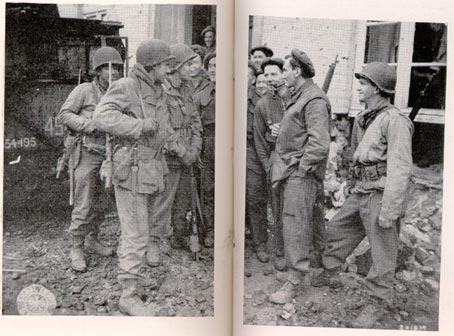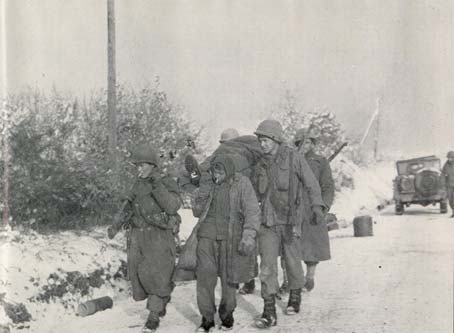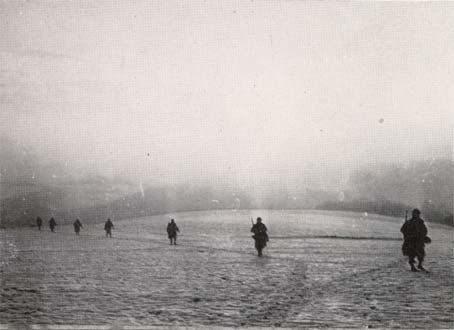|
Much of the fighting was confused as we did not know where
other units were located or where the enemy would appear from
next. From our right came troops of the 90th Division. From
the West came armored units from the Sixth Armored Division
helping to break the siege and moving into Bastogne and soon
to continue in a counter-offensive to the East and Northeast
out of Bastogne.

Americans meet the British
Our casualties had rapidly mounted. For example, the bitter
combat in and around the little village of Lutrebois, just
four miles from Bastogne, cost the Third Battalion of the
134th Infantry Regiment 400 casualties alone, with 32 of these
K.I.A.s. Grave registration teams reported a ratio of eight
German dead for each American killed. Most rifle companies
were reduced to one third normal strength. Our 100,000 artillery
shells were fired into the woods just East of Lutrebois, only
one small area of many similar sectors.
While the main part of the division remained locked with
the Germans, trading blows South of Bastogne, the 320th Regiment
was pulled out and sent into Bastogne and attached to the
6th Armored Division who needed additional infantry to start
the new offensive out of Bastogne, moving to the East toward
Bourcy where the Germans had occupied excellent defensive
positions for more than three weeks. The 320th attacked and
broke through the German perimeter across snowy fields on
January 15th, being relieved by the 134th Infantry three days
later alongside the 6th Armored which continued the offensive
eastward for several days longer, pursuing the now retreating
Germans. The remainder of the division was pulled out of the
line and entrucked to Metz. For rest? No. Because they were
needed to help stop another German offensive in the Seventh
Army sector.

A German prisoner helps American
GI's carry another wounded German prisoner of war to a jeep
ambulance near Harlange, Luxembourg. Both of the German prisoners
were in their teens.
The Ardennes campaign ended on January 25th. During the Battle
of the Bulge ( as history will know it) over a half million
American troops suffered more than 10 percent casualties.
German losses exceeded 220,000, of whom one half were killed
or wounded. History will record this as the largest land battle
ever fought by American troops. It was a victory as the result
of a tremendous team effort and the sacrifices by an uncounted
number of units and individuals. It is one of the great achievements
of American history and a matter of pride of American fighting
men. In our somewhat more than three weeks of fighting at
Bastogne, the 35th Division counted 1,034 German prisoners
and many more Germans killed and wounded. No G.I. could ever
doubt the commitment, the courage, and the determination of
the German soldier whom we met in the Ardennes. He had lost
the war but he was not yet a beaten man. By all logic the
war should have ended now and an armistice sought as Germany
had done in November of 1918. But Germany was under the grip
of a madman who would destroy his own country. The great Russian
offensive in the East ground steadily closer to Berlin, yet
Germany fought on.

Moonlight and cold - Luxembourg,
Belgium border.
For the 35th Division, there was to be no rest. When we had
pulled out of the Saarland shortly before Christmas, we had
been followed on the line along the Blies River by the 44th
and 87th Divisions from the Seventh Army. On January 1, 1945,
the Germans from behind the Siegfried Line and in the Colmar
pocket launched a surprise major offensive across and through
that line now defended by Gen. Dever’s Seventh U.S.
Army which included the French Divisions. Both the 44th and
87th Divisions were driven back across the Blies River for
several miles and the Seventh Army forced back into the Vosge
Mountains.
 Continue
to Page 3 of 3 Continue
to Page 3 of 3
|